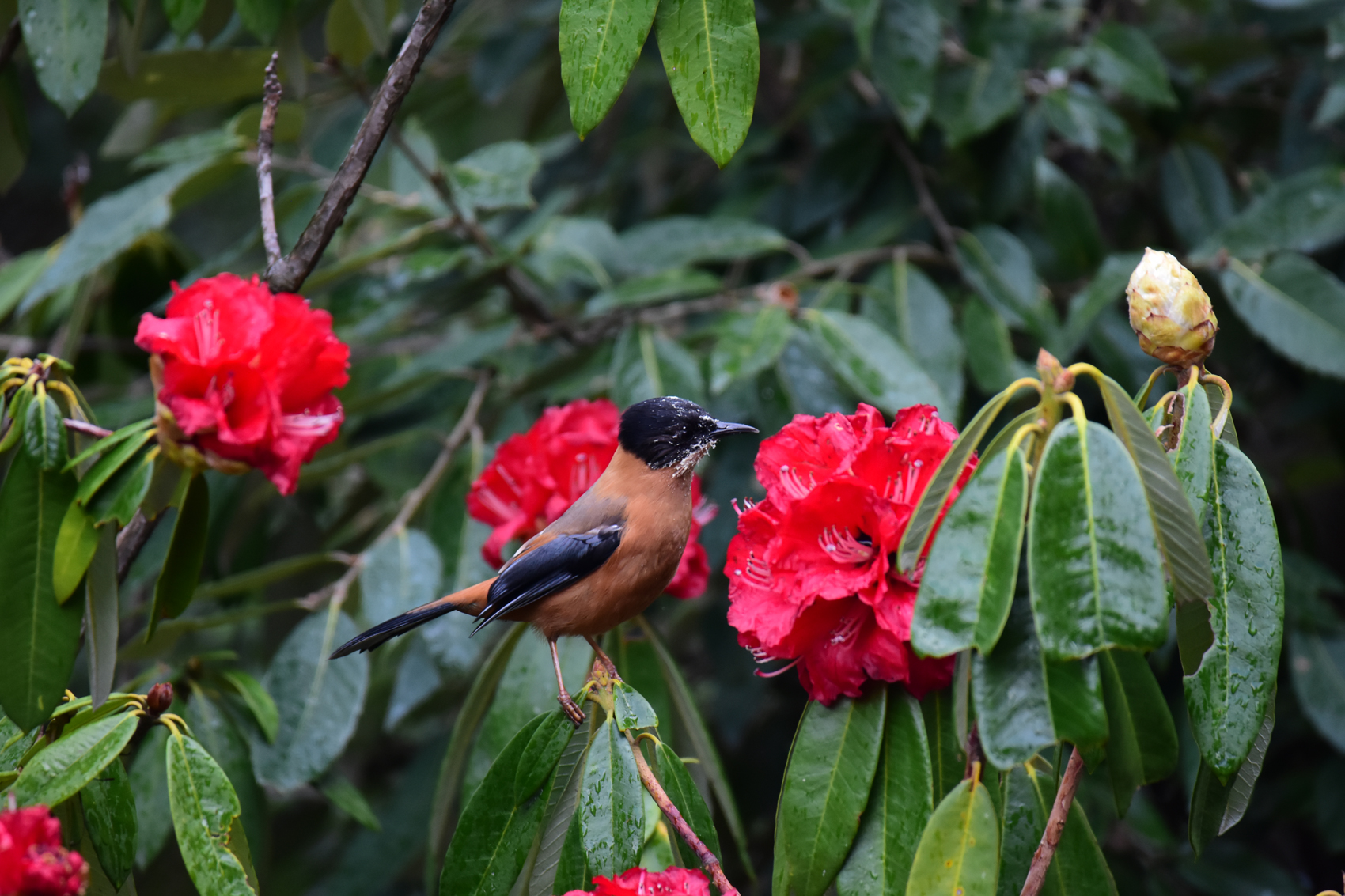Life In The Lived Landscape: A Decade Of Insights
First published in Sanctuary Asia,
Vol. 41
No. 10,
October 2021
By Ghazala Shahabuddin
Exactly 10 years ago, I first visited the hardwood oak forests of Mukteshwar, in Kumaon region of the western Himalaya. I had read much about the system of community-based forest management, the van panchayat. I was particularly keen to research the biodiversity aspects of this multiple-use landscape replete with traditional practices.
Almost immediately, I fell in love with the magnificent mountain views, the warmth of the local people and the incredible birdlife. More so, my intuition whispered to me that the dense, dark hardwood oak forests had far more to say than anyone had ever asked. Since that first trip, I have spent much of my time working on biodiversity research and outreach activities in this part of Kumaon. Every year brings new insights into the role of these forests in this fascinating human-dominated landscape.
The Health of a Forest
My long-term research goal has been to first understand the patterns of distribution of biodiversity in relation to land use and forest management practices, and second, to understand how and why wild species assemblages survive alongside people in this production landscape, using birds as indicators. I was naturally led to such questions by the intriguing co-existence of considerable wildlife – including mammals, reptiles, birds and butterflies – with human settlements and production systems.
Through dedicated and systematic bird surveys, mapping and analysis since 2013, my students Tarun Menon, Rajkamal Goswami, Ritobroto Chanda and Munish Gupta, were able to discern clear patterns of bird distributions across the different land uses. We have found that the mosaic of fields, protected and used oak forests, chir pine stands and now increasingly, built-up spaces, do sustain high bird diversity. This can be attributed to the tolerance of local people and traditional organic farming practices.
But we additionally found that the hardwood oak-dominated forests also play a critical role in sustaining landscape-level diversity by hosting forest specialist birds for which it appears to act as a source. Based on spatial analysis, we found that expansion of chir pine forests, over-exploitation of forest products, tourism infrastructure and highways, are enormously threatening biodiversity by degrading and fragmenting oak forests. Oak forest specialists, which prefer high-quality forests and insect-eating birds are most at risk, and the ‘defaunation’ (loss of fauna) because of land use change reaches up to 80 per cent in some cases. Our current research framework is ripe for extension into studies of climate change, as well as the ecological interactions that drive climate change – I hope to initiate these in late 2021.
Birds are only an indicator of the biophysical and socio-economic changes sweeping this interesting landscape. I aim to build knowledge on the biology of species across several different taxa, community ecology and ecosystem services, which can provide a base for future studies and ideate management strategies for western Himalayan forests. Thus, I have undertaken research on a wide range of issues: from the working of the van panchayat, chir pine expansion, herpetofaunal diversity and forest soil carbon depletion, to the regeneration of oak, fire ecology and butterfly micro-distributions. Recently, our collaborative study led to the confirmation of the popular narrative of the invasive nature of chir pine, which is fast spreading into hardwood oak stands. Thirteen students have led these studies over the years, and each of them has contributed to answering the seemingly simple research question I started with: how can we perpetuate the high animal diversity that this multiple-use landscape can host?
 A large variety of forest birds, such as the Rufous Sibia Heterophasia capistrata, feast on the nectar of vibrant rhododendron flowers, which are a vital food resource in the Himalayan landscape. Photo: Ghazala Shahabuddin
A large variety of forest birds, such as the Rufous Sibia Heterophasia capistrata, feast on the nectar of vibrant rhododendron flowers, which are a vital food resource in the Himalayan landscape. Photo: Ghazala Shahabuddin
Creating Value for All
Along with research, I have been part of a collective of individuals and NGOs, led by Titli Trust, that promote nature-based tourism. We believe community-based nature tourism activities are important to sustain rural livelihoods in the fragile Himalaya. We can count among our achievements, training 50-60 individuals to be nature guides, some of whom have also initiated conservation and education activities. We also publish field guides, posters and pamphlets on faunal groups for tourists, and promote the community-run birding destinations. For me, the hills and forests of Uttarakhand evoke wonderful memories of field training camps in scenic settings, where relationships have been forged amongst Forest Department officers, local youth, tourism entrepreneurs and biologists. These relationships hold fast to this day.
This unique synergy between scientists and local guides has also led to detailed documentation of flora and fauna in five training and tourism sites in Uttarakhand. This data is now accessible on e-Bird and iNaturalist. These few sites may now be the best documented in the western Himalaya, allowing for future research on a range of ecological issues.
In the Mukteshwar landscape alone, our students and trainees, led by K. Ramnarayan, have recorded over 139 species of butterflies and over 200 birds. Our activities have also led to numerous records of rare forest specialist species, many of which are endemic to the Himalaya, such as the butterfly species constable, purple emperor, golden birdwing and spotted palmfly. A range of endemic mountain herpetofauna such as the Kumaon bent-toed gecko and the Kumaon forest agama have also been photographed recently. In 2020, our trainees sighted the rare Rufous-backed Redstart in Mukteshwar valley, which was a new record for Uttarakhand.
I hope that we have been able to impart our own enthusiasm for nature and its protection to the local communities through the young people we work with.
 The grand duchess butterfly Euthalia patala is a Himalayan endemic that favours well-wooded streams in oak forest habitats. It is one of several species threatened by forest degradation and fragmentation. Photo: Sanjay Sondhi
The grand duchess butterfly Euthalia patala is a Himalayan endemic that favours well-wooded streams in oak forest habitats. It is one of several species threatened by forest degradation and fragmentation. Photo: Sanjay Sondhi
A recent string of devastating landslides, floods and forest fires in Uttarakhand and Himachal in 2021 have shown that the hardwood forests here, with their diversity of form and function, could be critical to the resilience of human settlements. Oak forests in the populated middle altitudes provide for year-round water availability, climatic modulation, slope stabilisation and even fire control. By letting the hardwood forests whittle away, and allowing the spread of chir pine, we are leaving the Himalayan slopes even more prone to water scarcity and landslides, and the local people to agrarian distress. In a rapidly warming Himalaya, public deliberation on such issues is of utmost urgency and importance.
I hope to continue to provide a much-needed platform to carry out field research and outreach activities in the Kumaon, to answer these and many other important questions of our times. Over the long term, I hope that our work in this culturally and biologically rich region will trigger the rethinking of development strategies for the larger Himalayan landscape.
Ghazala Shahabuddin has a Ph.D. in ecology from Duke University for which she studied the ecology of fruit-feeding butterflies in Venezuelan forest fragments. Since then, she has been researching a range of ecological problems in India. Her aim is to create nuanced public awareness about critical ecological issues in the country’s conservation landscape based on rigorous field research. She has published widely on wildlife policy and politics; her book Conservation at the Crossroads (Permanent Black and New India Foundation, 2010) examines diverse conservation paradigms in the Indian context. She is currently Visiting Professor in Environmental Studies at Ashoka University, Sonepat.



